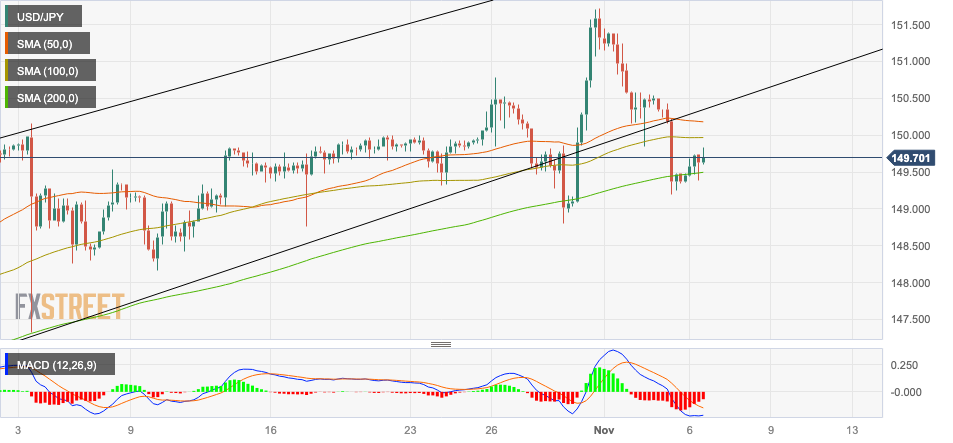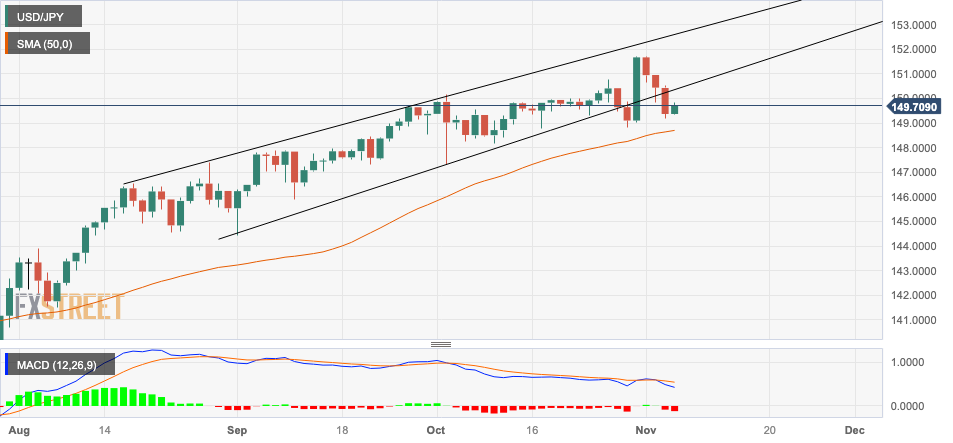Japanese Yen continues to slide against US Dollar, USD/JPY crosses 150
- The Japanese Yen weakens on Monday as the market mood turns upbeat.
- The BoJ gives mixed signals, saying it is normalizing on the one hand but then still easing.
- USD/JPY shows signs of weakness as the Federal Reserve is widely expected to keep rates unchanged, undermining USD.
The Japanese Yen (JPY) has steadily lost ground to the Greenback for most of Monday. The USD/JPY crossed above the 150 threshold in the afternoon. The overall positive market mood is favoring riskier currencies and not safe havens like the Yen.
The day’s temporary weakness is in line with the longer-term trend. Since 2021, the Japanese Yen – measured by the FXCM Index, which tracks the currency’s value against a basket of peers – has fallen over 33% in value at the start of the week.
The weakness was mainly due to the Bank of Japan’s (BoJ) policy of keeping interest rates sub-zero at a time when most other central banks were raising their interest rates to fight inflation. Since global investors tend to prefer parking their capital where it can manifest the highest risk-free returns, other currencies gained favor at the expense of the Yen.
More recently, with signs many central banks have reached or are close to reaching peak interest rates, the rate differential that was so detrimental to the Yen in the past could be finally closing. If the BoJ continues normalizing policy and other central banks stop raising rates or even begin cutting them, the Yen could start a recovery rally.
Daily digest market movers: Yen retreats as market mood lifts
- The Yen weakens at the start of the week as the market mood turns positive, favoring riskier currencies rather than safe havens.
- At its last meeting, the BoJ gave mixed signals. Whilst the board of governors made a step towards normalizing policy by relaxing the artificial cap it had imposed on 10-year Japanese Government Bond (JGB) yields – essentially a form of quantitative easing – Bank of Japan Governor Kazuo Ueda was clear there were no plans to raise interest rates yet.
- In fact, despite removing the yield cap, the Yen sold off after the meeting.
- The sell-off was put down to Governor Ueda’s remarks that most inflation was from higher commodity prices rather than increased demand, suggesting the BoJ would need to continue to keep monetary policy accommodative.
- Further, according to Reuters, the BoJ actually intervened to defend the 1.0% JGB cap on October 31 when yields almost reached it, suggesting the bank’s actions don’t follow its words, and de facto easing is still in place.
- According to analyst James Harte, of Tickmill Group, the BoJ is unlikely to raise rates anytime soon.
- "Ueda signaled that the prospect of negative rates being reversed this year was very low,” said Harte in a note, reported by Barron’s.
- The next key data release for Japan is Labour Cash Earnings for September, which is forecast to show a 1% rise YoY, when data is released at 22:30 on Monday.
- Overall Household Spending in the same month, released at the same time, is expected to show a -2.7% change YoY.
- If both metrics fall in line with estimates, the Yen is unlikely to gain much traction as it will suggest the subdued earning and spending cycle of past years, which has kept BoJ policy so accommodative, is still in effect.
- On Friday, the Yen gained against the US Dollar (USD) after the release of the October Nonfarm Payrolls report led traders to offload the Dollar.
- The report showed a weakening of most labor metrics in October, suggesting the Federal Reserve (Fed) could be done with raising interest rates.
Japanese Yen technical analysis: USD/JPY bear flag risks reversing short-term uptrend
USD/JPY – the amount of Yen that one Dollar buys – rises on Monday amidst a more upbeat market mood.
From a short-term perspective, the pair’s uptrend is perilously close to reversing. A break below the key 148.80 low of October 30 would provide evidence bears finally have the upper hand, as it is the last major lower high of the short-term uptrend.
Monday’s recovery looked at on the 4-hour chart resembles a bear flag pattern that could soon break lower and challenge those lows.

US Dollar vs Japanese Yen: 4-hour Chart
There are further signs of weakness too: the pair has cleanly broken out the rising channel it has been in – disrespecting the lower boundary line for the second time this week.
It has cut straight through the 50 and 100 4-hour Simple Moving Averages (SMA) and is wrestling with the 200.

US Dollar vs Japanese Yen: Daily Chart
On the daily chart, which reflects the medium-term trend, the pair is still in an uptrend. This continues to look solid except for the channel breakout. The 148.80 lows is still the level to watch. If it remains intact, a recovery continues to be probable. There is further support at the 50-day SMA at 148.63.
The Moving Average Convergence Divergence (MACD) indicator has been showing bearish divergence for some time. Nevertheless, this is not sufficient on its own to suggest the medium-term uptrend has reversed.
Ultimately, as the saying goes, the “trend is your friend” and for USD/JPY the short, medium and long-term trends are all still bullish, suggesting the odds continue to favor more upside eventually.
If the 151.93 level from October 2022 – which marked a 32-year-high – is breached, the uptrend will gain reconfirmation, with next targets expected to be met at the round numbers – 153.00, 154.00, 155.00 etc.
S&P 500 FAQs
What is the S&P 500?
The S&P 500 is a widely followed stock price index which measures the performance of 500 publicly owned companies, and is seen as a broad measure of the US stock market. Each company’s influence on the computation of the index is weighted based on market capitalization. This is calculated by multiplying the number of publicly traded shares of the company by the share price. The S&P 500 index has achieved impressive returns – $1.00 invested in 1970 would have yielded a return of almost $192.00 in 2022. The average annual return since its inception in 1957 has been 11.9%.
How are companies chosen to be included in the S&P 500?
Companies are selected by committee, unlike some other indexes where they are included based on set rules. Still, they must meet certain eligibility criteria, the most important of which is market capitalization, which must be greater than or equal to $12.7 billion. Other criteria include liquidity, domicile, public float, sector, financial viability, length of time publicly traded, and representation of the industries in the economy of the United States. The nine largest companies in the index account for 27.8% of the market capitalization of the index.
How can I trade the S&P 500?
There are a number of ways to trade the S&P 500. Most retail brokers and spread betting platforms allow traders to use Contracts for Difference (CFD) to place bets on the direction of the price. In addition, that can buy into Index, Mutual and Exchange Traded Funds (ETF) that track the price of the S&P 500. The most liquid of the ETFs is State Street Corporation’s SPY. The Chicago Mercantile Exchange (CME) offers futures contracts in the index and the Chicago Board of Options (CMOE) offers options as well as ETFs, inverse ETFs and leveraged ETFs.
What factors drive the S&P 500?
Many different factors drive the S&P 500 but mainly it is the aggregate performance of the component companies revealed in their quarterly and annual company earnings reports. US and global macroeconomic data also contributes as it impacts on investor sentiment, which if positive drives gains. The level of interest rates, set by the Federal Reserve (Fed), also influences the S&P 500 as it affects the cost of credit, on which many corporations are heavily reliant. Therefore, inflation can be a major driver as well as other metrics which impact the Fed decisions.